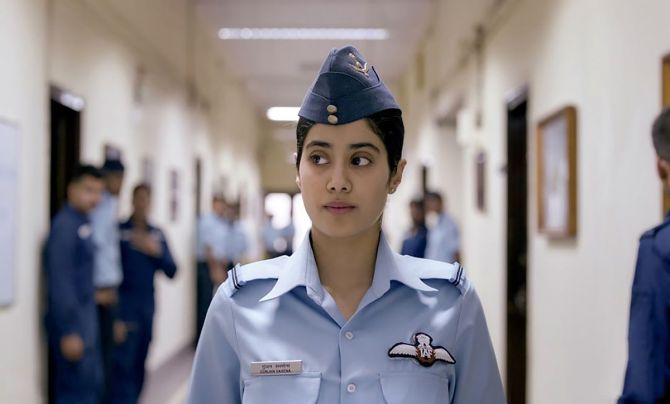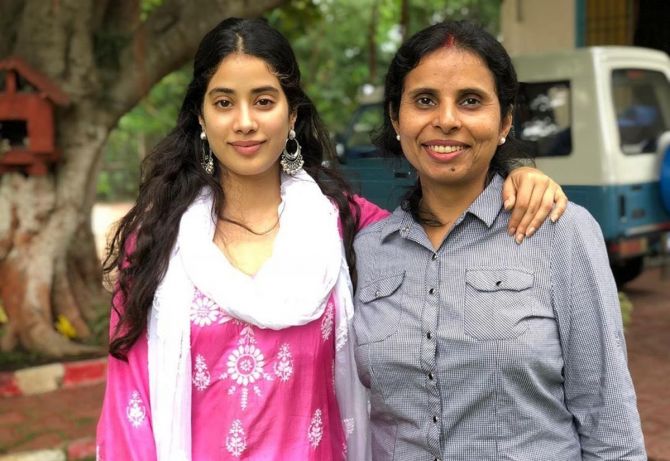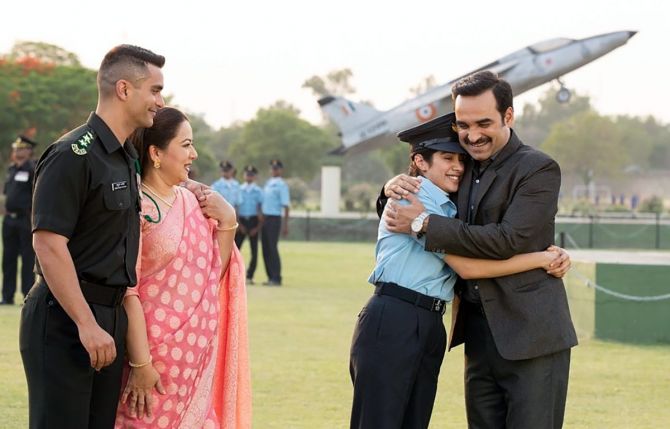 | « Back to article | Print this article |
The unfortunate thing is that the film will leave a poor impression of the IAF's and indeed of the armed forces's ability to handle sensitive social matters within their professional space, observes Lieutenant General Syed Ata Hasnain (retd).

The Indian Air Force is seething and rightly so.
Here comes a film -- Karan Johar's Gunjan Saxena: the Kargil Girl -- in which the producer and director had a basic theme to project -- the idea of gender equality and the resistance by the environment to achieve it.
It is a great theme, especially when related to the Indian armed forces.
Yet, it is so awfully researched and converted to storyline and screenplay that one cringes.
The story setting is on the IAF in 1994 or so.
The IAF emerges from it as a service living in the 19th century and unwilling to change.
It is supposedly based upon a true life story of one of the first woman pilots of the IAF trying to break a male bastion and the huge resistance (both institutional and otherwise) she finds in her path.
The IAF, like the other two services, had obviously taken a very brave decision in 1991 to induct Women Officers into service. There were teething problems, many of which continue to the day, but lack of sensitivity was surely not one of them.
Let us cut to the story first.
Gunjan Saxena (Jahnvi Kapoor, better known as the late Sridevi's daughter), the daughter of an Indian Army colonel, has a dream to be a pilot.
However, society at large has resistance to the idea of seeing women in such a role.
Encouraged by her doting father, she overcomes all obstacles in the path to becoming, not a commercial pilot, which she originally set her heart on, but an Indian Air Force helicopter pilot.
The IAF is correctly shown as a service which offers equal opportunities to all classes of society, unlike the world of a commercial pilot where only the financially better off can afford to pursue the dream of a pilot's license.
It is very well handled till here; the heart breaks at being found medically unfit and overcoming that, the entry into the Air Force Academy, the hard training she undergoes and the triumphant graduation as a pilot.

It is the story thereafter which bears no resemblance to truth starting with her elder brother (Angad Bedi) from the army (Punjab Regiment), dissuading her from joining her allotted unit after her commission as an officer in the IAF because he holds the lofty perception that women just aren't made for service in the armed forces.
His advice is virtual abetment to desertion, something which should have been known to the umpteen military advisers whose names appear in the credits at the beginning.
It is the arrival of Flying Officer Gunjan Saxena at the Udhampur Air Force base, having already earned her wings at the Air Force Academy, which creates a flutter.
The negativities begin to overwhelm the narrative.
The story writers basically wish to depict that institutionally and otherwise, the IAF was not prepared for nor willing to accept women into the ranks of those who flew the aerial war machines.
It was considered a male domain where during off time, the men indulged in horseplay, women talk and such like banter.
The entry of a woman, with availability of no special facilities for basic segregation in the crew room, of course, impinges on their space and they go into raptures to deny Gunjan Saxena even her professional rights of gaining expertise and experience as a pilot.
Humiliation by ignoring her and refusal to even socially interact are hugely laughable exaggerations.
The depiction of the Udhampur Air Force base in the film appears to project a bunch of shell shocked, strait jacketed male chauvinists who had no idea about the decisions taken by their hierarchy.
Rightly understandable among some young officers and junior other ranks, but to expect even senior officers indulging in deliberate attempts at mocking the physical mismatch of women and using this as lessons for their command is only condemnable.
The officer cadre of the armed forces lives by a concept of honour.
Insulting a comrade and denying her opportunities to develop her professional expertise surely finds no place within that ambit.

Some basic observations at this point, and these fully support former Wing Commander Namrita Chandi's very critical open letter published in a leading news magazine.
The IAF took the decision to induct WOs into branches other than the flying branch in 1991 and into the cadre of helicopter and transport aircraft pilots in 1994.
Momentous decisions such as these are accompanied by preparation of the environment.
There would definitely have been some misgivings at different levels, but in the armed forces, once a decision such as this is taken, you will attempt to resist it only at the risk to your own career.
Even in the Indian Army, WOs had to first learn the ropes under supervision, gain experience and seniority and only then were permitted to be convoy commanders, first in peace areas and later in even counter insurgency and high altitude areas.
No one attempted to embarrass them into submission to admit that they were not up to it.
Yes, there were problems such as toilets and matters of privacy, but all ranks were sensitive to it and improvisation was resorted to; who can better the 'jugaad' of the armed forces when it comes to such contingencies?
What the writers and the director wanted to do with this theme was to treat it in binary terms.
It appeared suitable to them to depict the IAF as an organisation inflexible in approach and completely dominated by insensitive men with no exposure to the fast changing world.
That would provide them enough stereotypes to project.
That situation could only change with contingencies which demanded operational involvement.
The real world Gunjan Saxena, on whom this story is based, had flown helicopters in a couple of missions during the Kargil War 1999. That seemed another sub story line to fit the circumstances to force a change of perception about the abilities of WOs.
No complaints about that, after all a director has to have some dramatic content to play upon.
It is the depiction of the terribly insensitive ways of the Udhampur Air Force base in which the story writers lost their bearings.
Instead, if they had chosen positivity to showcase how the IAF sensitively handled the challenging issues of initial induction of WOs (especially pilots), the extent to which their male counterparts made adjustments and their full commitment towards ensuring they would not allow any compromise in the progressive training of WOs, it would have given them enough anecdotal references to work upon and provide a feel good to the viewer.
As a soldier and senior officer, I can say with pride that some of the WOs I came across ensured by the dint of their sheer character and hard work that never did we have to think of shielding them in protected appointments.
I came across a WO, who was constructing an operational track in the dangerous Lipa Valley and was initially horrified to know that she slept on the deck of the single bulldozer available there and lived like that for three months.
The men were in awe of her personality and ability to lead by example.
As Adjutant of a Corps of Signals unit another WO commanded not just respect but the fear of her junior officers and the men. She could outrun most and put to shame others at the basketball court where she was the roughest player.
My Brigade Education Officer (a WO) accompanied me on many high altitude marches to visit troops at the LoC in the Uri sector.

The film is still watchable for some slick photography.
It is poorly acted. Jahnvi Kapoor just does not appear to have the bearing and body language of a confident military pilot, something which comes within weeks of academy training.
Angad Bedi is irritating while playing an old world elder brother, repeating his beliefs on gender capability mismatch at the drop of the hat.
What appears most surprising is that the IAF had full control on the shooting with its resources made available in abundance unless everything is through the new art of computer generation.
Surely its advisers would have had an idea of what was cooking in the pot; course correction could have then been advised.
Shooting letters now may not achieve much since there are enough disclaimers about the depiction of reality in the film.
The unfortunate thing is that the film will leave a poor impression of the IAF's and indeed of the armed forces's ability to handle sensitive social matters within their professional space.
As for my recommendation about watching the film, I will remain in the zone of grey.
If you have nothing to do in the evening and have worked from home the entire day, you could risk watching.
I found it to be a useful exercise in that age old army method of weapon training, called 'fault finding'.
Lieutenant General Syed Ata Hasnain (retd), PVSM, UYSM, AVSM, SM, VSM is one of India's most respected commentators on national security.
The general commanded the Indian Army's 15 Army Corps in Kashmir and was known as the 'People's General' in the Kashmir Valley.
General Hasnain is a frequent contributor to Rediff.com.
